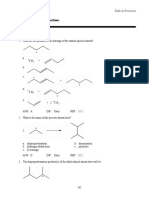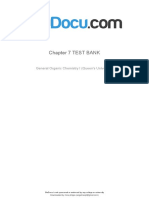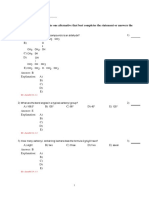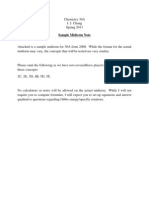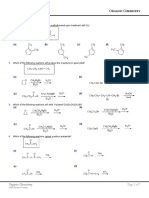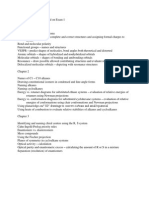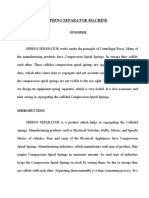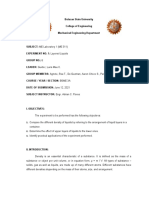Exam Three Practice Test
Exam Three Practice Test
Uploaded by
BUCH203Copyright:
Available Formats
Exam Three Practice Test
Exam Three Practice Test
Uploaded by
BUCH203Original Description:
Copyright
Available Formats
Share this document
Did you find this document useful?
Is this content inappropriate?
Report this DocumentCopyright:
Available Formats
Exam Three Practice Test
Exam Three Practice Test
Uploaded by
BUCH203Copyright:
Available Formats
1
CH203 Fall 2014 Exam Three Practice Test
11/24/14
1. Which of the following compounds is the strongest acid?
a. CH3CH2CH2COOH
b. CH3CH2CHClCOOH
c. CH3CHClCH2COOH
d. ClCH2CH2CH2COOH
2. Which of the following is the strongest base?
a. iodide anion, I
b. fluoride anion, F
c. bromide anion, Br
d. chloride anion, Cl
3. Which of the following compounds has the highest pKa?
a. NH3
b. H2O
c. HCl
d. CH4
4. Which of the following compounds has the lowest pKa?
a. H2O
b. HBr
c. NH3
d. CH4
5. Which of the following compounds has the lowest pKa?
a. H2O
b. H2S
c. H2Se
d. H2Te
6. Which of the following is present in the highest concentration upon dissolution of H2SO4 in
water?
a. H2SO4
b. H+
c. H3O+
d. HO
7. Which of the following is present in the highest concentration upon dissolution of acetic acid in
water?
a. OH
b. H3O+
c. CH3COOH
d. CH3COOH+
8.
Which of the following terms describes the reactivity of boron tribromide, BBr3?
a. Brnsted-Lowry acid and Lewis acid
b. Brnsted-Lowry base and Lewis base
c. Lewis acid and not a Brnsted-Lowry acid
d. Lewis base and not a Brnsted-Lowry base
9.
Which sets of curved arrows accounts for the protonation of propene with HI?
a.
b.
c.
d.
10.
Which species is the conjugate acid in the following acid-base reaction?
a.
b.
c.
d.
11.
1
2
3
4
1
2
3
4
What is the value of the equilibrium constant, Keq, for the following reaction?
a. 1013
b. 10 13
c. 13
d. 1/13
12.
Which of the following is a Lewis acid but not a Brnsted-Lowry acid?
a. CH3COOH
b. AlCl3
c. H2O
d. CH3OH
13.
Which of the following energy diagrams represents the slowest reaction?
a.
b.
c.
d.
1
2
3
4
14.
Which of the following is a definition of the rate-determining step of a reaction mechanism?
a. the first step
b. the last step
c. the step that crosses the highest energy barrier
d. the most exothermic step
15.
Which of the following is a definition of the activation energy of a reaction?
a. the difference in Gibbs free energy between the reactants and the transition state
b. the difference in Gibbs free energy between the reactants and the intermediate
c. the difference in Gibbs free energy between the reactants and the product
d. the difference in Gibbs free energy between the transition state and the product
16.
Which of the following energy diagrams best represents the changes in energy during addition of
HBr to an alkene?
a. 1
b. 2
c. 3
d. 4
17.
Use curved arrows to show the movement of pairs of electrons in the following acid-base
reaction and show the structures of the conjugate acid and conjugate base.
18.
Use curved arrows to show the movement of pairs of electrons in the following reaction between
a Lewis acid and a Lewis base, and show the structure of the product.
19.
What is the major organic product obtained from the following reaction?
a.
b.
c.
d.
20.
What is the major organic product obtained from the following reaction?
a.
b.
c.
d.
21.
1
2
3
4
1
2
3
4
What is the major organic product obtained from the following reaction?
a.
b.
c.
d.
22.
1
2
3
4
What is (are) the major organic product(s) obtained from the following reaction?
1.
2.
3.
a.
b.
c.
d.
24.
1
2
3
4
What is the major organic product obtained from the following reaction?
a.
b.
c.
d.
23.
(2R,3R)-dibromobutane
(2S,3S)-dibromobutane
meso-2,3-dibromobutane
only 1
only 2
only 3
only 1 and 2
What is (are) the major organic product(s) obtained from the following reaction?
1.
(2R,3R)-dibromobutane
2.
3.
a.
b.
c.
d.
25.
1
2
3
4
What is the major organic product obtained from the following reaction?
a.
b.
c.
d.
27.
only 1
only 2
only 3
only 1 and 2
What is the major organic product obtained from the following reaction?
a.
b.
c.
d.
26.
(2S,3S)-dibromobutane
meso-2,3-dibromobutane
1
2
3
4
What is (are) the major organic product(s) obtained from the following reaction?
1.
2.
3.
a.
b.
c.
d.
28.
a.
b.
c.
d.
only 1
only 2
only 3
only 1 and 2
(2R,3R)-butanediol
(2S,3S)-butanediol
meso-2,3-butanediol
only 1
only 2
only 3
only 1 and 2
What is the best choice of reagent to perform the following transformation?
a.
b.
c.
d.
30.
(2R,3R)-butanediol
(2S,3S)-butanediol
meso-2,3-butanediol
What is (are) the major organic product(s) obtained from the following reaction?
1.
2.
3.
29.
Br2
HBr
Br2, H2O
N-bromosuccinimide
What type of reactive intermediate is formed in the reaction of an alkene with Br2 and water to
give a bromohydrin?
a. carbocation
b. carbanion
c. radical
d. cyclic bromonium ion
31.
What type of reactive intermediate is formed in the reaction of an alkene with aqueous acid to
give an alcohol?
a. carbocation
b. carbanion
c. radical
d. carbene
32.
Which of the following reactions of alkenes takes place with anti stereospecificity?
a. bishydroxylation (treatment with OsO4 followed by NaHSO3)
b. hydrogenation (treatment with H2/Pt)
c. addition of HBr (treatment with HBr)
d. bromohydrin formation (treatment with Br2, H2O)
33.
Which of the following reactions of alkenes takes place with syn stereospecificity?
a. addition of bromine (treatment with Br2)
b. hydrogenation (treatment with H2/Pt)
c. addition of HBr (treatment with HBr)
d. acid-catalyzed hydration (treatment with aqueous H2SO4)
34.
What is the IUPAC name of the following compound?
a.
b.
c.
d.
35.
What is the major organic product obtained from the following reaction?
a.
b.
c.
d.
36.
(R)-4-methyl-2-hexyne
(S)-4-methyl-2-hexyne
(R)-3-methyl-4-hexyne
(S)-3-methyl-4-hexyne
(E) 2-butene
(Z) 2-butene
2-butyne
1-butyne
What is the major organic product obtained from the following reaction?
a.
b.
c.
d.
37.
3,4-dibromohexane
3,3-dibromohexane
(Z) 3,4-dibromohexene
3,3,4,4-tetrabromohexane
What is the major organic product obtained from the following reaction?
a.
b.
c.
d.
39.
2-methyl-3-hexene
2-methyl-3-heptyne
2-bromo-3-methylbutane
2-methyl-2-butene
What is the major organic product obtained from the following reaction?
a.
b.
c.
d.
38.
2-hexanone
hexanal
2-hexanol
cis-2-hexene
What is the major organic product obtained from the following reaction?
a. 1
b. 2
10
c. 3
d. 4
40.
What is the major organic product obtained from the following reaction?
a.
b.
c.
d.
41.
What is the major organic product obtained from the following reaction?
a.
b.
c.
d.
42.
1
2
3
4
1
2
3
4
What is the best choice of reagent(s) to perform the following transformation?
a.
b.
c.
d.
43.
H2/Pt
H2/Lindlar catalyst
Na/NH3
BH3; followed by H2O2, NaOH
What is the major organic product obtained from the following series of reactions?
a.
b.
c.
d.
45.
1 mol of Br2
2 mol of Br2
1 mol of HBr
2 mol of HBr
What is the best choice of reagent(s) to perform the following transformation?
a.
b.
c.
d.
44.
11
1
2
3
4
What is the major organic product obtained from the following series of reactions?
a.
b.
c.
d.
12
(Z)-2-heptene
(E)-2-heptene
1-heptene
heptane
46.
Outline how one might achieve the following transformation, showing reagents and the isolated
intermediates in the synthetic scheme.
47.
Outline how one might achieve the following transformation, showing reagents and the isolated
intermediates in the synthetic scheme.
48.
Predict the products:
OMe
HCl (1.0 equiv.)
49.
Predict the products:
Na or Li,
NH3 (liquid)
Me
Pd, H2,
H2, Lindlar Cat
Br2
2. (12 pts) Retrosynthesis
a.
13
alkyne
from
50.
b.
Provide the reaction conditions to synthesize the product from starting material A. Fill the missing
compound I and product II. Provide the reaction mechanism for step II.
c.
Product I
OCH3
Cl
H
H
OO
H
+
step I
step II
from alkene
from alkene
2. (12Hpts) Retrosynthesis
Mechanism
Addition of Br2 to cyclohexene. Be sure to indicate any relevant stereochemistry!
3
a. 3. (8 pts) OCH
Br 2
HO
from alkyne
A
Product II
Compound I
b. 11. (5 pts) When the following cyclic ether is treated with methanol(diastereomer
of product
and a catalytic
amountI)of H2SO4, one of the two
products shown is formed quantitatively with only a trace of the other. Which one is the major
product? Propose a
from alkene
reaction mechanism to illustrate why.
51.
c.
Suggest a starting material and reagent for the reaction:OCH3
CH3OH, H2SO 4
+
O
OCH3
HO
from alkene
The product on the right is the major one. Both carbocations are 2 , but the one that leads to the major product is
resonance stabilized by the lone pairs on the ether oxygen.
3. (8 pts) Mechanism Addition of Br2 to cyclohexene. Be sure to indicate any relevant stereochemistry!
Br 2the product and draw out the full mechanism of the reaction:
52. Predict
H
H
4. (8 pts) Mechanism Addition of H2O to cyclohexene. Be sure to indicate any relevant stereochemistry!
H 2O
O
O
H 2SO 4
53.
5. (5 pts) When the following cyclic ether is treated with methanol and a catalytic amount of H2SO4, one of the two
The
following
reaction
gives
mostly one
regioisomer
only
a trace
of the
the Propose a
products
shown
is formed
quantitatively
with
only a tracewith
of the
other.
Which
oneother.
is theDraw
major out
product?
reaction
and
explain
the formation of the product.
reaction mechanism
mechanism to
illustrate
why.
OCH3
CH3OH, H2SO 4
+
O
OCH3
12. (5 pts) You have learned that symmetrical dihalides (X2, X=Cl, Br) add to alkenes to form vicinal dihalides.
Unsymmetrical dihalides such as iodine monochloride (!"#) also add to alkenes. For the following addition reaction of
54.
In
following
product
is recovered.
it, and
why?
IClthe
to styrene
onlyreaction,
one of theonly
two one
indicated
products
is formed.Which
Pleaseproduct
indicateiswhich
one
and briefly state why.
4. (8 pts) Mechanism Addition of H2O to cyclohexene. Be sure to indicate any relevant stereochemistry!
H 2O
H 2SO 4
Chlorine is more electronegative than iodine. Therefore iodine would bear the partial positive charge in the mechanism
and add first. The cyclic iodonium ion would be broken by the chloride at the site that best handles positive charge the
secondary site. So the product on the right is preferred.
!+
!"
You might also like
- BR BR BR BRDocument47 pagesBR BR BR BRVesna NikolicNo ratings yet
- Practice Exam ChemDocument10 pagesPractice Exam Chemabhijit.salvekarNo ratings yet
- Chapter 15 Test Bank Chem 200Document123 pagesChapter 15 Test Bank Chem 200Lika GonashviliNo ratings yet
- ACS Review 12 Reactions of Arenes - Electrophilic Aromatic SDocument12 pagesACS Review 12 Reactions of Arenes - Electrophilic Aromatic SMohamad HabbabaNo ratings yet
- Organic Chem Practice Exam by Solomon CH 1-4Document12 pagesOrganic Chem Practice Exam by Solomon CH 1-4Natasha Moo100% (1)
- CHM 2210 Practice Exam 1Document12 pagesCHM 2210 Practice Exam 1Shaima MossamatNo ratings yet
- Chapter 17Document47 pagesChapter 17Luke Dhillon100% (1)
- Ch17-Pilihan Ganda Asam Karboksilat Dan TurunannyaDocument90 pagesCh17-Pilihan Ganda Asam Karboksilat Dan TurunannyaRiyanto Widodo100% (1)
- Organic Chemistry Help! Practice Exam Window For Xula-O1e2Document7 pagesOrganic Chemistry Help! Practice Exam Window For Xula-O1e2Kristia Stephanie BejeranoNo ratings yet
- Organic Chemistry 1 Multiple Choice: Cis TransDocument4 pagesOrganic Chemistry 1 Multiple Choice: Cis Transacb4039No ratings yet
- Chapter 11: Radical Reactions: Multiple ChoiceDocument24 pagesChapter 11: Radical Reactions: Multiple Choicelp_blackout50% (2)
- Chapter 5: Structure and Preparation of Alkenes - Elimination ReactionsDocument13 pagesChapter 5: Structure and Preparation of Alkenes - Elimination ReactionsRahma AshrafNo ratings yet
- ch13 ProblemsDocument84 pagesch13 Problemsbrownhazel67% (6)
- PMR Spectroscopy: Solved Problems Volume : IIFrom EverandPMR Spectroscopy: Solved Problems Volume : IIRating: 5 out of 5 stars5/5 (3)
- CH CH CCH C CHDocument15 pagesCH CH CCH C CHVirgilio Ebajo Jr.No ratings yet
- Che 232 Test 1 Sptember 2007Document16 pagesChe 232 Test 1 Sptember 2007BONOLO RANKONo ratings yet
- TBA Chapter9Document23 pagesTBA Chapter9Ha Vi100% (1)
- CHM 2210 Practice Exam 3Document8 pagesCHM 2210 Practice Exam 3Shaima MossamatNo ratings yet
- Practice CH 22 AnsDocument33 pagesPractice CH 22 AnsDante Ramoth75% (4)
- A HW5 (CH17)Document19 pagesA HW5 (CH17)Kunal VermaNo ratings yet
- Quiz 3-Practice questions (1) نسخةDocument8 pagesQuiz 3-Practice questions (1) نسخةSabaa AbuzaidNo ratings yet
- Aromatic Cmpds AnskeyDocument6 pagesAromatic Cmpds AnskeyAaron LeeNo ratings yet
- ACS Review 9 AlkynesDocument9 pagesACS Review 9 AlkynesMohamad HabbabaNo ratings yet
- OCHEM Practice FinalsDocument13 pagesOCHEM Practice FinalsNoleNo ratings yet
- ACS Review 18 Enols and EnolatesDocument11 pagesACS Review 18 Enols and EnolatesJana BazziNo ratings yet
- Organic Chemistry TestDocument1 pageOrganic Chemistry Testron971No ratings yet
- Chem 1040 Final Exam ReviewDocument8 pagesChem 1040 Final Exam ReviewUzair AliNo ratings yet
- Oc ch17Document34 pagesOc ch17xavier8491No ratings yet
- Chapter 12: Reactions of Arenes - Electrophilic Aromatic SubstitutionDocument29 pagesChapter 12: Reactions of Arenes - Electrophilic Aromatic SubstitutionRahma AshrafNo ratings yet
- Chapter 7 TEST BANK Chapter 7 TEST BANKDocument61 pagesChapter 7 TEST BANK Chapter 7 TEST BANKangelineNo ratings yet
- Chapter-7 Key AnswersDocument40 pagesChapter-7 Key AnswersJesseth AlotaNo ratings yet
- Chapter Alkyne 8.12.2021Document41 pagesChapter Alkyne 8.12.2021Nurul HassanNo ratings yet
- ACS Review 15 Alcohols Diols and ThiolsDocument10 pagesACS Review 15 Alcohols Diols and ThiolsJana BazziNo ratings yet
- Chapter 08 MergedDocument38 pagesChapter 08 MergedreemNo ratings yet
- Chapter 2, Acids and BasesDocument13 pagesChapter 2, Acids and BasesSheree Jones FinleyNo ratings yet
- CH 7Document71 pagesCH 7Moira Mochie C. BasilioNo ratings yet
- Practices Exam - Organic Chemistry To 2nd PartialDocument10 pagesPractices Exam - Organic Chemistry To 2nd PartialShary MosqueraNo ratings yet
- Chapter 6: Reactions of Alkenes - Addition Reactions: Trans-1,2-Dimethylcyclopentane Cis-1,2-DimethylcyclopentaneDocument21 pagesChapter 6: Reactions of Alkenes - Addition Reactions: Trans-1,2-Dimethylcyclopentane Cis-1,2-DimethylcyclopentaneRahma AshrafNo ratings yet
- Stereochemistry QustionsDocument43 pagesStereochemistry QustionsSwaraj Paul100% (1)
- ch02 Test BankDocument66 pagesch02 Test BankEyaNo ratings yet
- Class-XII (Chemistry) Chapter: Alcohols, Phenols and Ethers Objective Type QuestionsDocument9 pagesClass-XII (Chemistry) Chapter: Alcohols, Phenols and Ethers Objective Type QuestionsPranav DhimanNo ratings yet
- CH 07Document61 pagesCH 07Simranjit Kaur75% (4)
- Organic Chemistry 2 Practice Exam 1Document15 pagesOrganic Chemistry 2 Practice Exam 1KaybidoNo ratings yet
- Organic Chemistry Problem SetDocument10 pagesOrganic Chemistry Problem SetBermonica Alvior SatuitoNo ratings yet
- ACS Review 17 Aldehydes and Ketones - Nucleophilic AdditionDocument14 pagesACS Review 17 Aldehydes and Ketones - Nucleophilic AdditionJana Bazzi100% (1)
- Chapter 8 Nucleophilic Substitution: Answers Prof. Sivaguru JayaramanDocument16 pagesChapter 8 Nucleophilic Substitution: Answers Prof. Sivaguru JayaramanRahma AshrafNo ratings yet
- Qoii0708 CO 17 TIFDocument34 pagesQoii0708 CO 17 TIFLovely Joysweet100% (2)
- Test Bank For Organic Chemistry 11th Edition by Solomons (Chapter 1) Test Bank For Organic Chemistry 11th Edition by Solomons (Chapter 1)Document64 pagesTest Bank For Organic Chemistry 11th Edition by Solomons (Chapter 1) Test Bank For Organic Chemistry 11th Edition by Solomons (Chapter 1)angelineNo ratings yet
- ACS Review 22 AminesDocument10 pagesACS Review 22 AminesJana BazziNo ratings yet
- CH 14Document28 pagesCH 14ffffffff dfdfdfNo ratings yet
- Section-I (Single Correct Choice) : HC CH 1.1eq Nanh Nanh Nanh X XDocument14 pagesSection-I (Single Correct Choice) : HC CH 1.1eq Nanh Nanh Nanh X XPriyansh YadavNo ratings yet
- Practice Chapter 19 QuesDocument28 pagesPractice Chapter 19 QuesRosalina CabaNo ratings yet
- Organic Chemistry Practice MidtermDocument7 pagesOrganic Chemistry Practice MidtermAmy HanNo ratings yet
- Houston Community College System: Organic Chemistry II 2425Document19 pagesHouston Community College System: Organic Chemistry II 2425Banele Ezma LambathaNo ratings yet
- Chapter 15Document27 pagesChapter 15anastark100% (6)
- Alkanes Alkenes AlkynesDocument10 pagesAlkanes Alkenes AlkynesPanda Boy100% (2)
- Practice Questions-Conformational AnalysisDocument4 pagesPractice Questions-Conformational AnalysisHarry Zgambo100% (1)
- Ch18 - Chapter 18 Questions For Boson Ch18 - Chapter 18 Questions For BosonDocument135 pagesCh18 - Chapter 18 Questions For Boson Ch18 - Chapter 18 Questions For BosonKathy YellaNo ratings yet
- Exam Three Practice Test Answers PDFDocument19 pagesExam Three Practice Test Answers PDFBUCH203100% (1)
- Problem Set - Organic ChemDocument7 pagesProblem Set - Organic ChemGela EcalNo ratings yet
- The Chemistry of AN ONION: Amino Acid SulfoxidesDocument9 pagesThe Chemistry of AN ONION: Amino Acid SulfoxidesBUCH203No ratings yet
- 36 CH203 Fall 2014 Lecture 36 December 5 PDFDocument48 pages36 CH203 Fall 2014 Lecture 36 December 5 PDFBUCH203No ratings yet
- Exam Three Practice Test Answers PDFDocument19 pagesExam Three Practice Test Answers PDFBUCH203100% (1)
- 32 DR Zhou Lecture 32 PDFDocument23 pages32 DR Zhou Lecture 32 PDFBUCH203No ratings yet
- 31 CH203 Fall 2014 Lecture 31 PDFDocument22 pages31 CH203 Fall 2014 Lecture 31 PDFBUCH203No ratings yet
- CH203 Fall 2014 Exam Two Practice Test With AnswersDocument10 pagesCH203 Fall 2014 Exam Two Practice Test With AnswersBUCH203No ratings yet
- CH203 Fall 2014 NMR Practice Quiz 1 Answers PDFDocument8 pagesCH203 Fall 2014 NMR Practice Quiz 1 Answers PDFBUCH20350% (2)
- CH203 Fall 2014 NMR Practice Quiz 1Document8 pagesCH203 Fall 2014 NMR Practice Quiz 1BUCH203100% (1)
- CH203 Fall 2014 Exam 1 Grading Key PDFDocument8 pagesCH203 Fall 2014 Exam 1 Grading Key PDFBUCH203No ratings yet
- Possible Topics To Be Covered On Exam 1Document1 pagePossible Topics To Be Covered On Exam 1BUCH203No ratings yet
- Atterberg Limit PDFDocument5 pagesAtterberg Limit PDFsanduni100% (1)
- FT-Goma GuarDocument1 pageFT-Goma GuarMaria CalderonNo ratings yet
- Tutorial Modeling Uniform Fluidization in 2D Fluidized BedDocument10 pagesTutorial Modeling Uniform Fluidization in 2D Fluidized BedNui Computercenter Swu OnkNo ratings yet
- Moringa Oleifera Seed Oil: Composition and Characterization of Cold PressedDocument12 pagesMoringa Oleifera Seed Oil: Composition and Characterization of Cold PressedKarima GharsallahNo ratings yet
- PP8 - Free FallDocument19 pagesPP8 - Free FallShwe EainNo ratings yet
- IS FormDocument43 pagesIS FormShivkumar VijapureNo ratings yet
- EVT577 Wastewater Exp2 CODDocument7 pagesEVT577 Wastewater Exp2 CODFadzrilNo ratings yet
- Matter: Quarter 1: Module 5 - 7Document29 pagesMatter: Quarter 1: Module 5 - 7Aizy AlmosaraNo ratings yet
- SPM 2003-2008 Ch6 NucleurDocument10 pagesSPM 2003-2008 Ch6 NucleurADY2022No ratings yet
- Biosensors by RRDocument6 pagesBiosensors by RRKp PrakashNo ratings yet
- Group8 168 185 188 1.2Document5 pagesGroup8 168 185 188 1.2darshil shahNo ratings yet
- Six Basic Curing SystemsDocument13 pagesSix Basic Curing Systemshoneylet tayactacNo ratings yet
- PPL Q. Bank (Nav)Document45 pagesPPL Q. Bank (Nav)Sabik Rahim100% (1)
- Master Thesis Report-Yassine BADDOUDocument47 pagesMaster Thesis Report-Yassine BADDOUghaffarNo ratings yet
- Irel Pdac 2014Document42 pagesIrel Pdac 2014Hemant SharmaNo ratings yet
- Influence of Aluminum and Copper Alloy MachinabilityDocument13 pagesInfluence of Aluminum and Copper Alloy MachinabilitySathish KumarNo ratings yet
- Poc 2 MCQDocument20 pagesPoc 2 MCQj setty81% (26)
- Name: - Form: - Date: - Lesson 1 - Linear Motion A) IntroductionDocument26 pagesName: - Form: - Date: - Lesson 1 - Linear Motion A) Introductionpallz007No ratings yet
- Xii-Neet, Jee Segment Iii, Iv Time Table-1Document2 pagesXii-Neet, Jee Segment Iii, Iv Time Table-1Javith Abdul SalamNo ratings yet
- Electrostatics - Electrical Multiple Choice Questions and Answers PDF - Preparation For EngineeringDocument19 pagesElectrostatics - Electrical Multiple Choice Questions and Answers PDF - Preparation For EngineeringRamaprasad Panda75% (4)
- Experiment 1Document20 pagesExperiment 1Shelvin NaiduNo ratings yet
- Isolation and Characterization of Collagen From Fish Waste Material-Skin, Scales and Fins of Catla Catla and Cirrhinus MrigalaDocument10 pagesIsolation and Characterization of Collagen From Fish Waste Material-Skin, Scales and Fins of Catla Catla and Cirrhinus MrigalaIrpan RomadonaNo ratings yet
- Ami Seawater Desalination Ro MembranesDocument1 pageAmi Seawater Desalination Ro MembranesbarsathNo ratings yet
- TAPPI TIP-0402-03 Overlay Rev 2005Document10 pagesTAPPI TIP-0402-03 Overlay Rev 2005a_parratNo ratings yet
- Rev SPRING SEPARATORDocument8 pagesRev SPRING SEPARATORAswin MNo ratings yet
- Broek 2Document533 pagesBroek 2José Luis Arana BilbaoNo ratings yet
- Solid State Welding (SSW)Document15 pagesSolid State Welding (SSW)SmithNo ratings yet
- Utilization of Guinea Corn (Sughurm Vulgare) Husk For Preparation of Bio-Based Silica and It's Characterization StudiesDocument6 pagesUtilization of Guinea Corn (Sughurm Vulgare) Husk For Preparation of Bio-Based Silica and It's Characterization StudiesIJEAB JournalNo ratings yet
- ME Laboratory 1 Experiment No. 1Document7 pagesME Laboratory 1 Experiment No. 1Aaron Choco De GuzmanNo ratings yet
- Combustion PSETDocument3 pagesCombustion PSETGeloii PandaNo ratings yet










